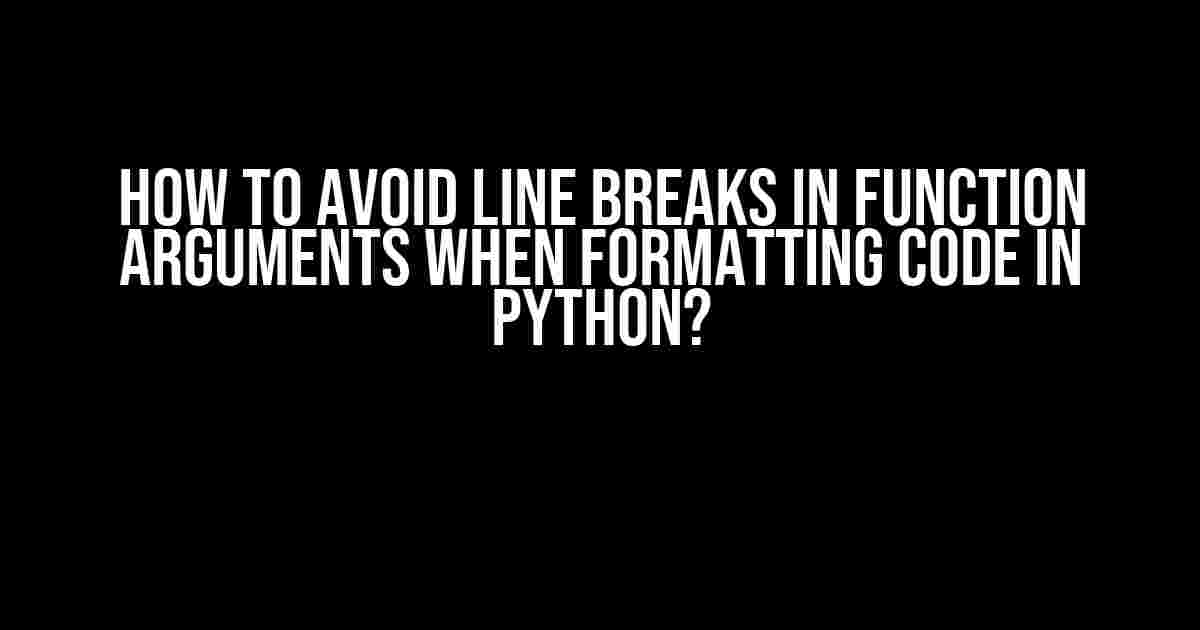Are you tired of dealing with line breaks in function arguments when formatting code in Python? You’re not alone! It’s a common issue that can make your code look cluttered and hard to read. But fear not, dear Pythonista, for we’ve got the solution right here! In this article, we’ll show you how to avoid line breaks in function arguments and keep your code looking sleek and stylish.
- Why Do Line Breaks in Function Arguments Happen?
- Why Should You Avoid Line Breaks in Function Arguments?
- Solution 1: Use Implicit Line Joining
- Solution 2: Use Explicit Line Joining
- Solution 3: Use a Consistent Line Length
- Solution 4: Use a Code Formatter
- Best Practices for Avoiding Line Breaks in Function Arguments
- Conclusion
Why Do Line Breaks in Function Arguments Happen?
Before we dive into the solution, let’s quickly discuss why line breaks in function arguments happen in the first place. There are a few reasons for this:
- PEP 8 Compliance: Python’s official style guide, PEP 8, recommends keeping lines of code under 79 characters. When function arguments exceed this limit, editors and IDEs may automatically insert line breaks to comply with this guideline.
- Editor Settings: Some editors and IDEs have settings that auto-format code, inserting line breaks to improve readability. While this is helpful, it can lead to line breaks in function arguments.
- Code Complexity: When function arguments become too long or complex, it’s natural to break them up onto multiple lines for easier reading. However, this can lead to line breaks that make the code harder to understand.
Why Should You Avoid Line Breaks in Function Arguments?
Now that we know why line breaks in function arguments happen, let’s discuss why you should avoid them:
- Readability: Line breaks in function arguments can make the code harder to read, especially when there are multiple arguments or complex expressions involved.
- Maintenance: When line breaks are inserted, it becomes more difficult to understand the intent behind the code, making maintenance and debugging a challenge.
- Consistency: Inconsistent line breaks can lead to inconsistencies in code formatting, making it harder for others (and yourself) to read and understand the code.
Solution 1: Use Implicit Line Joining
One way to avoid line breaks in function arguments is to use implicit line joining. This involves using parentheses to group function arguments and allowing Python to implicitly join the lines:
def my_function(
arg1, arg2, arg3,
arg4, arg5, arg6):
pass
In the above example, we’ve grouped the function arguments using parentheses, allowing Python to join the lines implicitly. This approach is PEP 8 compliant and keeps the code readable.
Solution 2: Use Explicit Line Joining
Another way to avoid line breaks in function arguments is to use explicit line joining. This involves using the `\` character to explicitly join lines:
def my_function(arg1, arg2, arg3, \
arg4, arg5, arg6):
pass
In this example, we’ve used the `\` character to explicitly join the lines, keeping the function arguments on a single line. This approach is also PEP 8 compliant and easy to read.
Solution 3: Use a Consistent Line Length
A third approach to avoiding line breaks in function arguments is to maintain a consistent line length. This involves setting a maximum line length and formatting the code accordingly:
def my_function(arg1, arg2, arg3,
arg4, arg5, arg6,
arg7, arg8, arg9):
pass
In this example, we’ve maintained a consistent line length of approximately 80 characters, making the code easy to read and understand. This approach is also PEP 8 compliant and helps maintain consistency in code formatting.
Solution 4: Use a Code Formatter
Finally, you can use a code formatter like Black, Prettier, or YAPF to automatically format your code and avoid line breaks in function arguments. These tools can be configured to follow PEP 8 guidelines and maintain a consistent code style:
pip install black black my_script.py
In this example, we’ve installed the Black code formatter and run it on our script, `my_script.py`. Black will automatically format the code, avoiding line breaks in function arguments and maintaining a consistent code style.
Best Practices for Avoiding Line Breaks in Function Arguments
To avoid line breaks in function arguments, follow these best practices:
- Keep function arguments short and concise: Aim to keep function arguments under 79 characters to avoid line breaks.
- Use implicit or explicit line joining: Use parentheses or the `\` character to group or join function arguments, respectively.
- Maintain a consistent line length: Set a maximum line length and format your code accordingly to maintain consistency.
- Use a code formatter: Configure a code formatter like Black, Prettier, or YAPF to automatically format your code and avoid line breaks in function arguments.
- Follow PEP 8 guidelines: Adhere to PEP 8 guidelines for code formatting, including line length, indentation, and spacing.
Conclusion
Avoiding line breaks in function arguments is crucial for maintaining readable, maintainable, and consistent code. By using implicit line joining, explicit line joining, maintaining a consistent line length, or using a code formatter, you can keep your code looking sleek and stylish. Remember to follow PEP 8 guidelines and best practices to ensure your code is easy to read and understand.
| Solution | Description |
|---|---|
| Implicit Line Joining | Use parentheses to group function arguments and allow Python to implicitly join the lines. |
| Explicit Line Joining | Use the `\` character to explicitly join lines and keep function arguments on a single line. |
| Consistent Line Length | Maintain a consistent line length and format code accordingly to avoid line breaks. |
| Code Formatter | Use a code formatter like Black, Prettier, or YAPF to automatically format code and avoid line breaks in function arguments. |
By following these solutions and best practices, you’ll be well on your way to writing clean, readable, and maintainable Python code. Happy coding!
Frequently Asked Question
Get ready to tame those pesky line breaks in your Python code and make it look slick and readable!
Q1: Why do line breaks occur in function arguments while formatting code in Python?
Line breaks occur when the code formatter, such as Black or Flake8, tries to adhere to the maximum line length limit (usually 88 or 120 characters) and wraps the code to the next line. This can lead to unreadable code, especially when working with long function calls or list comprehensions.
Q2: How can I use parentheses to avoid line breaks in function arguments?
Wrap the function arguments in parentheses, and the formatter will keep them on the same line. For example: `my_function((arg1, arg2, arg3))`. This trick works wonders for short function calls, but what about longer ones?
Q3: Can I use backslashes to avoid line breaks in function arguments?
Yes! You can use backslashes (`\`) to continue the line. For instance: `my_function(arg1, arg2, \ arg3, arg4)`. This method is more readable than parentheses, but it can still get messy with longer argument lists.
Q4: Is there a more Pythonic way to format long function arguments?
One elegant solution is to use implicit line continuation, where you place the arguments on separate lines with indentation. For example: `my_function( arg1, arg2, arg3, arg4 )`. This approach is more readable and maintainable, especially when working with complex function calls.
Q5: What about using a code formatter that respects my coding style?
A great solution is to choose a code formatter that allows you to customize the formatting rules, such as Black or Yapf. These tools can be configured to respect your coding style and avoid line breaks in function arguments. Simply configure the formatter to your liking, and let it do the heavy lifting for you!


